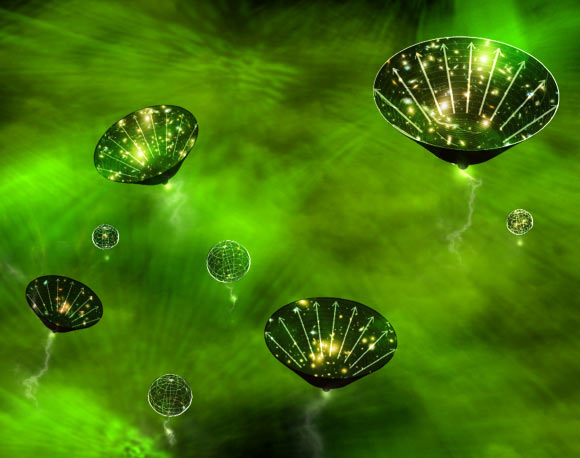In a new paper in the journal Physical Review Letters, an international team of theoretical physicists described a scenario for the formation of primordial black holes from vacuum bubbles in the early Universe and discussed its intriguing realization that can naturally account for all of the dark matter.

‘Baby universes’ branching off of our Universe shortly after the Big Bang appear to us as black holes. Image credit: Kavli Institute for the Physics and Mathematics of the Universe.
Primordial black holes are hypothetical compact objects that formed in the early Universe prior to any galaxies and stars.
They are a viable candidate for dark matter, the missing matter that astrophysicists think makes up 85% of the Universe.
First proposed several decades ago, these compact objects could play a central role in a variety of astrophysical phenomena, such as progenitors for gravitational waves and seeds for formation of supermassive black holes.
They could also play a role in the synthesis of heavy elements when they collide with neutron stars and destroy them, releasing neutron-rich material.
In the new paper, Dr. Alexander Kusenko from the Kavli Institute for the Physics and Mathematics of the Universe and the University of California, Los Angeles and his colleagues from Japan, the United States and Taiwan described a ‘multiverse’ scenario of primordial black hole formation.
“The early Universe was so dense that any positive density fluctuation of more than 50% would create a black hole,” they explained.
“However, cosmological perturbations that seeded galaxies are known to be much smaller. Nevertheless, a number of processes in the early Universe could have created the right conditions for the black holes to form.”
“One exciting possibility is that primordial black holes could form from the ‘baby universes’ created during inflation, a period of rapid expansion that is believed to be responsible for seeding the structures we observe today, such as galaxies and clusters of galaxies.”
“During inflation, baby universes can branch off of our Universe. A small baby (or ‘daughter’) universe would eventually collapse, but the large amount of energy released in the small volume causes a black hole to form.”
“An even more peculiar fate awaits a bigger baby universe. If it is bigger than some critical size, Einstein’s theory of gravity allows the baby universe to exist in a state that appears different to an observer on the inside and the outside.”
“An internal observer sees it as an expanding universe, while an outside observer sees it as a black hole.”
“In either case, the big and the small baby universes are seen by us as primordial black holes, which conceal the underlying structure of multiple universes behind their event horizons.”
Dr. Kusenko and co-authors also showed that primordial black holes can be detected using the Hyper Suprime-Cam (HSC) of the 8.2-m Subaru Telescope.
“We demonstrate with numerical studies that future observations of HSC, as well as other optical surveys, such as the Vera C. Rubin Observatory, will be able to provide a definitive test for this generic primordial black hole formation mechanism if it is the dominant source of dark matter,” they said.
_____
Alexander Kusenko et al. 2020. Exploring Primordial Black Holes from the Multiverse with Optical Telescopes. Phys. Rev. Lett 125 (18): 181304; doi: 10.1103/PhysRevLett.125.181304







